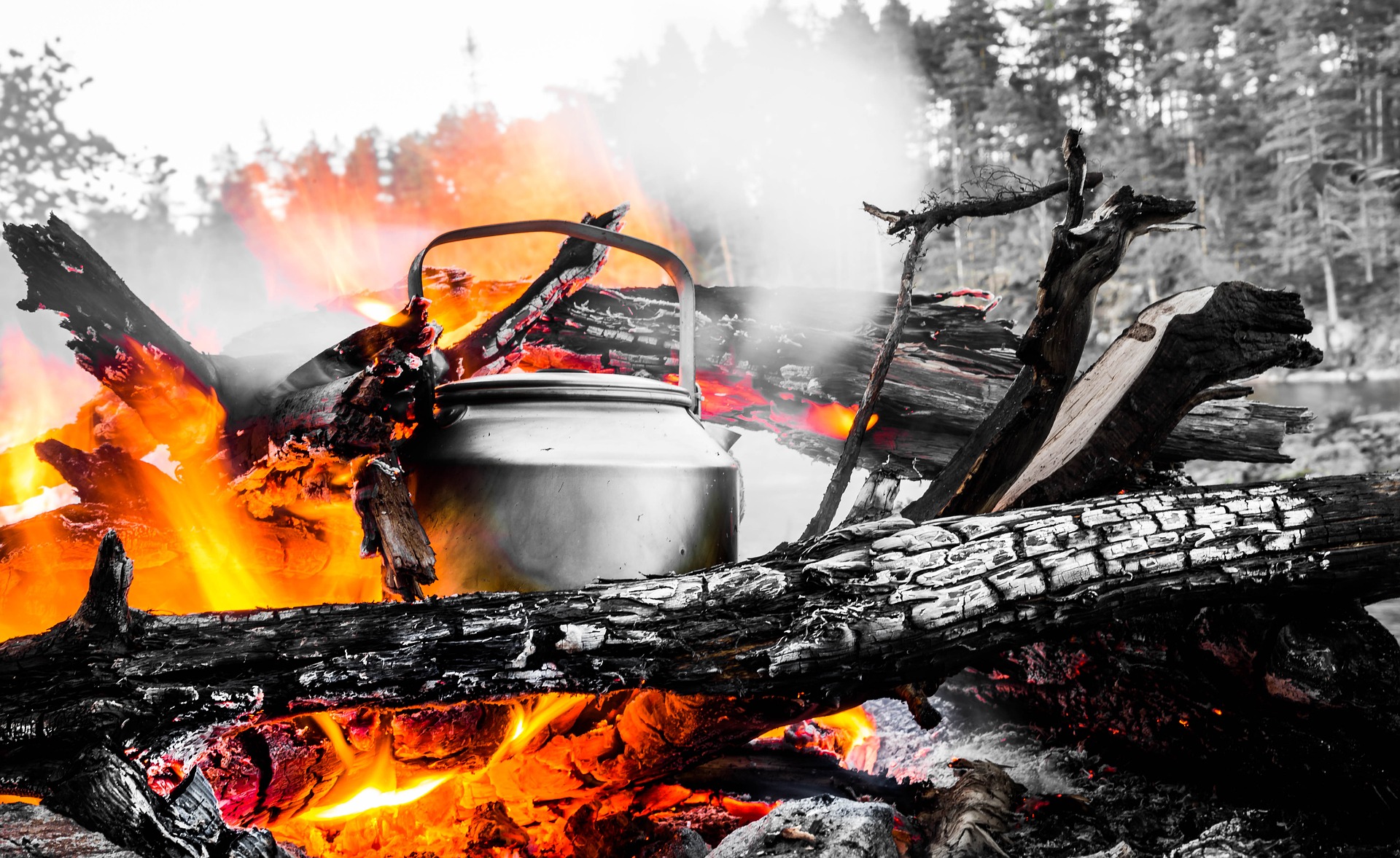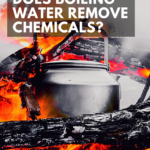Whether you’re at home on a municipal water supply system that’s had a problem, out backpacking with a broken water filter, or trying to provide for your family after a natural disaster, making water safe to drink is a skill that can quite literally make the difference between life and death.
When the threat is microbial, the most common solution is boiling. But does boiling water help remove chemical contaminants?
Boiling water can remove chemicals with a lower boiling point than water, like benzene and some other Volatile Organic Compounds (VOCs). However, for many other chemicals like arsenic or mercury, boiling will only increase the concentration in the water that remains.
For more info on the types of contaminants that can be found in water, check out my full article “What Contaminants are in River Water?”
Table of Contents
What Kind of Chemicals can Boiling Remove?
The reason boiling is so effective against microorganisms is that they are living things, only harmful when alive. Giardia and cryptosporidium, for example, are parasitic microbes that make people sick with diarrhea and vomiting. But once they’re cooked through by boiling, they cease to be problematic.
Boiling chemicals doesn’t kill them, because they weren’t alive in the first place. Similarly, the neurotoxins from cyanobacteria, or blue-green algae, are not alive. They’re a chemical threat to our bodies, and also not inactivated by boiling.
The only chemicals that can be removed through boiling alone are those that boil off, out of the water, at a lower temperature than water boils. Different substances have different boiling points, which is what makes distillation of alcohol possible.
How Alcohol Distillation Works
Alcohol boils at 173°F (83°C), while water boils at 212°F (100°C). That means that a mixture of alcohol and water (such as beer, wine, or a distiller’s mash) held at a temperature between those two, say 194°F (90°C), will boil only the alcohol.
Distillers take advantage of this by holding a mash (rough beer made from grains, sugar, or anything else fermented a while) at the right temperature to boil off just alcohol vapors.
They then collect those vapors into water-cooled coils, which drops the temperature of the vapors cold enough to condense back into nearly pure alcohol. This alcohol is mixed back down to tolerable levels, normally about 40 percent alcohol by volume, and either packed up to be sold directly or aged a while before sale.
Back to Water and Chemical Contaminants
In water treatment, the goal is to purify the water, rather than concentrate spirits. Pure water contaminated with pure benzene could be made safe to drink by holding the water at 180°F (82°C) until it stopped bubbling, and then a while longer as a safety factor.
The benzene, with a boiling point of 176°F (80°C), will have all boiled away, leaving pure water behind.
The trouble is, unless you know exactly what chemical contaminants are in the water, you can’t know if boiling will make it safe. Barring a spill of a known chemical into the water supply, say a benzene truck crashing into the reservoir, that water should still be treated as suspect.
Even with a know source chemical, care should still be taken, as who knows what other sorts of organic contaminants might be in the water, reacting with the benzene and forming higher boiling point chemicals that are still dangerous to ingest.
As a side note: raising the temperature of water could promote all sorts of reactions between chemicals present in it. Some chemical reactions require a certain temperature to provide the “activation energy” needed to react. With a known contaminant, it may be possible to add another chemical to react with it and either precipitate out, or render the original contaminant harmless. Heat might help some of those reactions along, but all of this is better suited for a chemistry laboratory than your kitchen or campsite!
What Removes Other Chemicals?
Chemicals that are dissolved in water can’t be filtered out. Think of trying to filter salt out of sea water, you need a fancy and expensive purpose-built reverse-osmosis setup to physically strain out the salt.
Unless there’s a difference in boiling point (or freezing point, a chemical that freezes at a warmer temperature than water could be precipitated out that way) to exploit, the only thing for it is a chemical reaction.
There are two approaches, and two levels of specificity that can be applied to reacting out contaminants.
The first approach is removal of the chemical, and the second is inactivation.
Removal of Chemicals
The chemical contaminant can be reacted with something solid that can be pulled back out of the water, like a rod of metal or carbon.
Otherwise it can be reacted with another chemical mixed into the water to form a substance that is insoluble, or will settle out of the water to deposit on the bottom.
Iron is reacted out of water in this way. Oxidizers like potassium permanganate are added to the water, reacting with the iron to form an iron oxide that settles out.
Precipitation reactions require a specific knowledge of what contaminants are present, which puts them out of reach for anyone without a full water chemistry set.
However, a more general approach can be taken with the solid reaction method. Some substances react with lots of different chemicals, and a great one in particular is Activated Carbon.
Activated Carbon is carbon (normally charcoal) that has been heated to temperatures in excess of 1800°F (1000°C) or reacted with some very caustic chemicals to greatly increase its surface area. It reacts with many harmful chemicals, and is used as a final “polishing” step in both conventional drinking water treatment plants and many in-home water filters.
Do not use the “make your own activated charcoal with lemon juice” techniques, they are fake and could quite literally kill you. Ask yourself if there would be huge industrial furnaces dedicated to superheating charcoal if all it took was a little lemon juice. You can grab it pretty cheap for use in home aquariums.
Click here to check the price of Activated Charcoal on Amazon!
Backpacking Water Filter with Activated Carbon – Katadyn Vario

Backpacking filters are great for purifying water on the go. These days, they feature fine enough filtration to catch even cryptosporidium, the smallest microorganism targeted by the US EPA water standards.
If you grab a dual filter with Activated Carbon in it, like the Katadyn Vario, then you’ll have some good protection against low concentrations of chemicals as well. Definitely the easiest way to deal with chemicals in the woods!
Click Here to check the current price of the Katadyn Vario on Amazon!
Inactivation of Chemicals
Not all “chemicals” are bad for us. In fact, many are vital for our survival.
Table salt, sodium chloride, is a valuable electrolyte that helps the body’s nervous system send messages. Bleach (sodium hypochlorite) is not good for us to drink, but through a series of chemical reactions, it can be reverted back to the table salt it was made from.
There exist a variety of such chemical hazards that can be inactivated by the experienced chemist, but that is another topic better suited for the chemistry laboratory than our kitchens and campsites.
Further Reading on Making Water Safe
I hope you’ve enjoyed this article and learned something new in the process.
If you’re looking to learn more, check out a few of my other articles on Making Water Safe:
- Does Filtering Water Make it Safe to Drink?
- Water Filtration and Disinfection – Why you Need Both
- What Contaminants are in River Water?
Or grab my book “Water Treatment Skills: Filtration, Disinfection, Distillation, and More for the Adventurer or Prepper” (available as an e-book or paperback) on Amazon!


